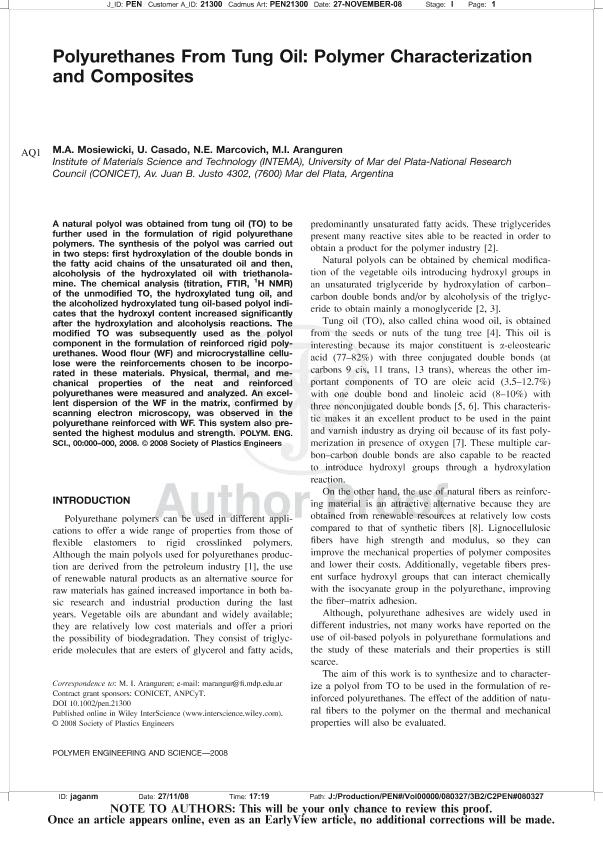Artículo
Polyurethanes from tung oil: Polymer characterization and composites
Mosiewicki, Mirna Alejandra ; Casado, Ulises Martín
; Casado, Ulises Martín ; Marcovich, Norma Esther
; Marcovich, Norma Esther ; Aranguren, Mirta Ines
; Aranguren, Mirta Ines
 ; Casado, Ulises Martín
; Casado, Ulises Martín ; Marcovich, Norma Esther
; Marcovich, Norma Esther ; Aranguren, Mirta Ines
; Aranguren, Mirta Ines
Fecha de publicación:
04/2009
Editorial:
John Wiley & Sons Inc
Revista:
Polymer Engineering and Science
ISSN:
0032-3888
Idioma:
Inglés
Tipo de recurso:
Artículo publicado
Clasificación temática:
Resumen
A natural polyol was obtained from tung oil (TO) to be further used in the formulation of rigid polyurethane polymers. The synthesis of the polyol was carried out in two steps: first hydroxylation of the double bonds in the fatty acid chains of the unsaturated oil and then, alcoholysis of the hydroxylated oil with triethanolamine. The chemical analysis (titration, FTIR, 1H NMR) of the unmodified TO, the hydroxylated tung oil, and the alcoholized hydroxylated tung oil-based polyol indicates that the hydroxyl content increased significantly after the hydroxylation and alcoholysis reactions. The modified TO was subsequently used as the polyol component in the formulation of reinforced rigid polyurethanes. Wood flour (WF) and microcrystalline cellulose were the reinforcements chosen to be incorporated in these materials. Physical, thermal, and mechanical properties of the neat and reinforced polyurethanes were measured and analyzed. An excellent dispersion of the WF in the matrix, confirmed by scanning electron microscopy, was observed in the polyurethane reinforced with WF. This system also presented the highest modulus and strength.
Palabras clave:
Natural Polyol
,
Reinforced Polyurethanes
,
Vegetable Oil
,
Wood Flour
Archivos asociados
Licencia
Identificadores
Colecciones
Articulos(INTEMA)
Articulos de INST.DE INV.EN CIENCIA Y TECNOL.MATERIALES (I)
Articulos de INST.DE INV.EN CIENCIA Y TECNOL.MATERIALES (I)
Citación
Mosiewicki, Mirna Alejandra; Casado, Ulises Martín; Marcovich, Norma Esther; Aranguren, Mirta Ines; Polyurethanes from tung oil: Polymer characterization and composites; John Wiley & Sons Inc; Polymer Engineering and Science; 49; 4; 4-2009; 685-692
Compartir
Altmétricas



